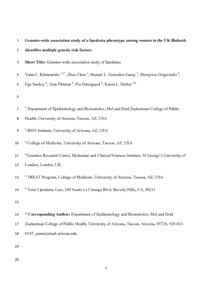Klimentidis, YC; Chen, Z; Gonzalez-Garay, ML; Grigoriadis, D; Sackey, E; Pittman, A; Ostergaard, P; Herbst, KL
(2023)
Genome-wide association study of a lipedema phenotype among women in the UK Biobank identifies multiple genetic risk factors.
European Journal of Human Genetics, 31 (3).
pp. 338-344.
ISSN 1018-4813
https://doi.org/10.1038/s41431-022-01231-6
SGUL Authors: Ostergaard, Pia Pittman, Alan Michael Sackey, Ege Gulce
![[img]](https://openaccess.sgul.ac.uk/115001/1.hassmallThumbnailVersion/Klimentidis_accepted%20for%20publication.pdf)  Preview |
|
PDF
Accepted Version
Available under License ["licenses_description_publisher" not defined].
Download (531kB)
| Preview
|
Abstract
Lipedema is a common disorder characterized by excessive deposition of subcutaneous adipose tissue (SAT) in the legs, hips, and buttocks, mainly occurring in adult women. Although it appears to be heritable, no specific genes have yet been identified. To identify potential genetic risk factors for lipedema, we used bioelectrical impedance analysis and anthropometric data from the UK Biobank to identify women with and without a lipedema phenotype. Specifically, we identified women with both a high percentage of fat in the lower limbs and a relatively small waist, adjusting for hip circumference. We performed a genome-wide association study (GWAS) for this phenotype, and performed multiple sensitivity GWAS. In an independent case/control study of lipedema based on strict clinical criteria, we attempted to replicate our top hits. We identified 18 significant loci (p < 5 × 10−9), several of which have previously been identified in GWAS of waist-to-hip ratio with larger effects in women. Two loci (VEGFA and GRB14-COBLL1) were significantly associated with lipedema in the independent replication study. Follow-up analyses suggest an enrichment of genes expressed in blood vessels and adipose tissue, among other tissues. Our findings provide a starting point towards better understanding the genetic and physiological basis of lipedema.
Statistics
Item downloaded times since 21 Nov 2022.
Actions (login required)
 |
Edit Item |


